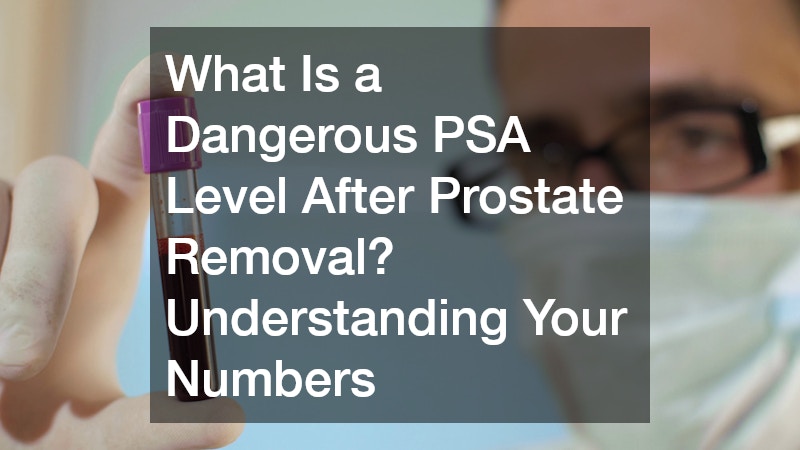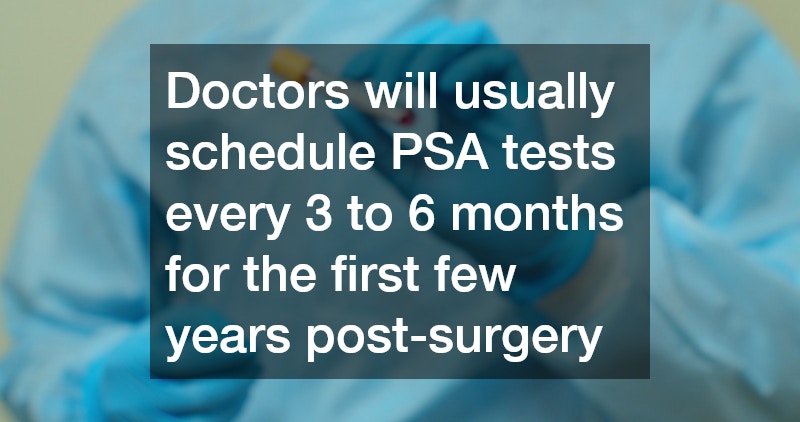
If you’ve recently had a prostatectomy (prostate removal surgery), or you’re supporting someone who has, you may be wondering: what exactly is a dangerous PSA level after prostate removal? PSA, or prostate-specific antigen, is a key marker doctors use to track prostate health — but how do these levels change once the prostate is out? And when should you worry?
In this article, we’ll break down what PSA means after surgery, what numbers are considered risky, and what you can expect moving forward. No confusing medical jargon here — just straightforward answers and helpful tips.
What Is PSA and Why Does It Matter After Prostate Removal?
PSA, or prostate-specific antigen, is a protein mainly produced by cells in the prostate gland. Under normal circumstances, PSA is found in very low levels in the bloodstream. Its primary function is to help liquefy semen, but because it leaks into the blood, PSA levels become a useful marker for prostate health.
Before surgery, elevated PSA levels can suggest prostate cancer, benign prostate enlargement (BPH), or inflammation (prostatitis). Doctors use PSA tests as part of prostate cancer screening and monitoring.
But what happens after the prostate is removed?
Since the prostate gland is the main source of PSA, removing it should cause PSA levels to drop dramatically — ideally to nearly zero or undetectable levels. This sharp decline is a critical sign that the surgery was successful in removing the tissue that produces PSA.
Why is this important?
- If PSA remains detectable or starts to rise after prostatectomy, it could mean there are still prostate cells somewhere in the body. These could be benign leftover cells, or worse — cancer cells that might be growing again.
- Detecting these changes early through PSA testing allows doctors to intervene before the cancer spreads or causes symptoms.
- Essentially, PSA becomes a sensitive “early warning system” after prostate removal. Because there is no longer a prostate gland, even tiny amounts of PSA in the blood can be significant.
How Soon Should PSA Levels Drop After Surgery?
Right after prostate removal surgery, PSA levels don’t plummet instantly — it takes some time for your body to clear out the existing PSA in the bloodstream.
- Typically, PSA levels fall rapidly over the first several weeks. Most patients see their PSA drop below 0.1 ng/mL within about 4 to 6 weeks after surgery.
- This 0.1 ng/mL threshold is important because PSA levels above this after six weeks could suggest residual prostate tissue or cancer.
- If PSA does not drop to near zero in this timeframe, your doctor will likely want to investigate further to rule out persistent disease.
After that initial drop, doctors will usually schedule PSA tests every 3 to 6 months for the first few years post-surgery. This frequent monitoring helps catch any rises in PSA early on.
What Is a Dangerous PSA Level After Prostate Removal?
Understanding PSA numbers after prostatectomy can feel confusing, but here’s a straightforward breakdown:
| PSA Level (ng/mL) | What It Usually Means |
| Less than 0.1 | Normal — expected after successful prostate removal |
| 0.1 to 0.2 | Borderline — PSA detectable but low; needs close monitoring |
| Above 0.2 | Concerning — generally considered biochemical recurrence, meaning the cancer may be returning |
What is biochemical recurrence?
This term means that PSA levels have risen above 0.2 ng/mL on two consecutive tests after surgery. It is a strong indicator that some cancer cells may have survived or returned.
This doesn’t necessarily mean cancer has spread extensively, but it signals that your healthcare team should evaluate you for further treatment options.
Why Does PSA Sometimes Rise After Surgery?
You might wonder why PSA would ever come back after removing the entire prostate gland. Here are some common reasons:
- Residual Prostate Tissue: Sometimes, small bits of prostate tissue are left behind during surgery, especially if the cancer was near the edges of the gland.
- Cancer Recurrence: Prostate cancer cells can remain undetected in surrounding tissues or lymph nodes and grow over time, causing PSA to rise.
- Inflammation or Infection: Urinary tract infections or prostatitis-like inflammation in nearby tissues can cause temporary PSA spikes.
- Lab or Testing Variability: Rarely, lab errors or biological fluctuations can cause PSA to appear elevated. This is why doctors look for rising trends rather than single readings.
Because of these possibilities, your doctor won’t make treatment decisions based on a single PSA test but will watch for consistent increases.
What Happens If PSA Levels Rise? Should You Panic?
A rising PSA after prostate removal can be concerning but try to keep calm.
Here’s what usually happens next:
- Confirmatory Testing: Your doctor will order repeat PSA tests every few months to confirm the increase isn’t a one-time blip.
- Imaging Studies: If PSA continues to rise, imaging like MRI, CT scans, or bone scans might be ordered to look for local recurrence or spread.
- Treatment Planning: If cancer recurrence is confirmed, treatments such as radiation therapy targeting the prostate bed or hormone therapy to block testosterone may be recommended.
The key is to catch the rise early so treatment can be more effective. Rising PSA is a signal to take action — but not necessarily a sign of immediate danger.
How Is PSA Monitored After Prostate Removal?
After surgery, PSA monitoring is an ongoing process tailored to each patient’s risk and health status. A typical schedule looks like this:
- First 2 years: PSA every 3 to 6 months. This period carries the highest risk for recurrence.
- Years 3 to 5: If PSA remains undetectable, testing may be reduced to every 6 to 12 months.
- After 5 years: If stable, annual PSA tests may be sufficient.
Your doctor will adjust the frequency based on your initial cancer characteristics and PSA trends.
Regular monitoring is crucial because early detection of recurrence offers more treatment options and better outcomes.
What Are the Risk Factors for a Dangerous PSA Rise?
Certain clinical features make a PSA rise more likely after surgery:
- High Gleason Score: This grading system assesses cancer aggressiveness. Higher scores (8–10) have a greater chance of recurrence.
- Positive Surgical Margins: Cancer cells found at the edge of the removed tissue suggest some tumor may have been left behind.
- Advanced Tumor Stage: Tumors that have grown beyond the prostate capsule or spread to lymph nodes increase recurrence risk.
- Higher Pre-Surgery PSA: Elevated PSA before surgery is linked to more aggressive disease.
Your care team uses this information to decide how aggressively to monitor you and when to intervene.
What Is the Role of PSA Doubling Time?
PSA doubling time measures how quickly PSA levels double over time and is a powerful predictor of cancer behavior.
- Short doubling time (<3 months): Indicates rapidly growing cancer. This usually requires prompt, aggressive treatment.
- Intermediate doubling time (3–12 months): Suggests moderate risk; treatment timing depends on other factors.
- Long doubling time (>12 months): Indicates slower progression; sometimes doctors prefer active surveillance before starting therapy.
Calculating PSA doubling time helps your doctor tailor treatment plans to your specific situation.
Can Lifestyle Affect PSA Levels After Prostate Removal?
While PSA is mainly a biological marker, your overall health and lifestyle can impact cancer outcomes and possibly PSA trends over the long term.
Some healthy habits that support recovery and well-being include:
- Healthy Diet: Emphasize fruits, vegetables, lean proteins, and whole grains, which provide antioxidants and nutrients that may help control cancer growth.
- Regular Exercise: Moderate physical activity improves immune function and reduces inflammation.
- Avoid Smoking: Tobacco use is linked to worse prostate cancer outcomes.
- Limit Alcohol: Excessive drinking can negatively affect your immune system and overall health.
Though lifestyle changes don’t directly lower PSA after surgery, they support your body and may improve response to treatment if recurrence happens.
What Are the Treatment Options if PSA Is Dangerous After Prostate Removal?
If your PSA rises to concerning levels, several treatment options may be recommended:
Radiation Therapy
- Often called salvage radiation, it targets any remaining cancer cells in the prostate bed or nearby areas.
- It’s most effective when started early after PSA rise.
- Can be combined with hormone therapy for better results.
Hormone Therapy (Androgen Deprivation Therapy)
- Prostate cancer growth is fueled by testosterone.
- Hormone therapy reduces testosterone levels or blocks its effects to slow cancer growth.
- May be used alone or with radiation, especially if cancer has spread.
Clinical Trials and New Treatments
- Depending on your situation, you might qualify for experimental therapies or immunotherapy.
- These can offer additional options when conventional treatments are less effective.
Your healthcare provider will discuss the best approach based on your PSA trends, overall health, and preferences.
What Questions Should You Ask Your Doctor About PSA Levels?
To stay informed and involved, consider asking:
- What is my current PSA level, and what does it mean?
- How often will you test my PSA moving forward?
- What PSA level would be concerning for me?
- What are the next steps if my PSA starts to rise?
- Are there any lifestyle changes I should consider?
- Should I be worried about side effects of potential treatments?
Key Takeaways: Understanding PSA Levels After Prostate Removal
- PSA should drop to nearly zero after prostate removal.
- PSA above 0.2 ng/mL on two tests suggests biochemical recurrence.
- Rising PSA is a warning sign, not a definite diagnosis of cancer spread.
- Regular PSA monitoring is critical to catch recurrence early.
- Treatment options exist and are more effective when started promptly.
- Stay proactive with your healthcare team and follow recommended testing schedules.
Common Myths About PSA After Prostate Removal
Let’s clear up some misconceptions:
- Myth: PSA should always be zero after surgery.
Reality: PSA is usually undetectable but can be very low (below 0.1). - Myth: Any detectable PSA means cancer is back.
Reality: Small rises might be due to benign reasons or leftover tissue. - Myth: PSA rise means immediate treatment is necessary.
Reality: Doctors often confirm trends and assess risk before acting.
How to Stay Calm While Waiting for PSA Results
Waiting for PSA test results can be nerve-wracking. Here are tips to manage anxiety:
- Stay busy with hobbies and activities you enjoy.
- Talk openly with your support network.
- Ask your healthcare provider for clarity on what to expect.
- Practice relaxation techniques like meditation or deep breathing.
Final Thoughts
Knowing what is a dangerous PSA level after prostate removal is vital for anyone who’s had a prostatectomy. It helps you understand your health status, recognize when to seek medical advice, and stay on top of your recovery.
Remember, a rising PSA is not a verdict but a signal. With regular monitoring and prompt care, many men live healthy, active lives long after surgery.
If you have concerns about your PSA levels or prostate cancer follow-up, don’t hesitate to reach out to your healthcare provider. Being informed and proactive is your best defense.





